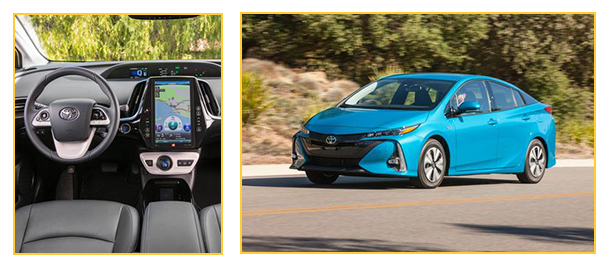Test Drive Notes Library
-
 Pros
Pros
- More usable all-electric range now. The old Prius Plug-In Hybrid had about 13 miles of all-electric range. The new Prius Prime doubles that to 25 miles. For a lot of people, with reasonably short commutes, that means effectively driving an electric car most of the time, while knowing you can still drive it 400-plus miles in gasoline/hybrid mode before having to stop for fuel. In combined city and highway driving, we got 78 mpg equivalent, recharging it at every opportunity (home, work, and parking lots where charging was available). Mike drop.
- Reliable. The Prius was the first popular gasoline hybrid, and it's known for its durability and reliability.They use ‘em for taxi cabs, and we’ve seen many go 200,000-plus miles. While most manufacturers have now joined the hybrid club, Toyota has been doing it for nearly two decades, and knows how to make them durable and mostly trouble free.
- Practical packaging. Five doors are great for versatility. You can seat four passengers (not five in this particular Prius, see below), and have a hatchback for easy loading and unloading of cargo. Fold down the rear seats, and the average Prius Prime driver can haul a month’s worth of kale.
- Handling. The suspension is improved from the previous generation of Prii. While it will never be confused with a sports car, or sporty car, the handling is much better, and the whole car feels more solid on the road, operates with less body lean, and the rear end is less jolted by bumps.
- Torque. It has three drive modes, Eco, Normal, and Sport. “Eco" is for those who are determined to get 78.1 MPGe, and are never in a hurry. “Normal" feels plenty peppy in electric mode with its excellent torque, and feels like a Prius in gasoline-hybrid mode. Still, Toyota gets credit for its smooth, and barely noticeable switching back and forth from electric to gasoline power. “Sport" is actually a bit too much, if you can believe it. The car almost jumps forward in battery mode, making it annoying in traffic. Plus it kills the battery quickly, which kind of defeats the purpose of buying a plug-in Prius. So who uses Sport mode? Let's call it “Husband Who Never Wanted to Buy a Damn Prius Anyway" Mode.
- On the highway, running on battery power, there’s plenty of zip for passing. The Prius Prime has lots of torque under battery power, and has no problem adding speed quickly and smoothly. Need to zoom up to 80 and pass a truck? Done. It’s a far better performing car in battery mode than in gasoline/hybrid mode.
- Standard Safety. Our top trim Prius Prime “Advanced", which lists for about $36K, comes standard with forward collision warning and automatic emergency braking, blind spot monitoring, and cross traffic alert. Lesser trims, impressively, all come with forward collision warning and automatic emergency braking (sold as Toyota Safety Sense). But the highly desirable blind spot warning (especially with the Prius’s mediocre rear-three-quarter visibility), is only available on the Advanced trim.
- Heads Up Display. Also available only on the Advanced trim model, the heads-up display shows your speed, navigation instructions, and remaining battery information. It's projected from the dashboard and appears to be floating at the end of the hood as you drive. The battery information is the stuff that Prius drivers tend to obsess over on their center screens, so putting it in the heads up display may help Prius drivers keep their eyes on the road and prevent a few more of them from crashing into the back of milk trucks.
- Visibility is quite good up front. Quite not-so-good to the rear, and rear three-quarter view. But that’s par for the course these days. Blind spot monitoring is highly recommended. In comparison to the Chevy Volt, the Prius feels spacious and airy. And visibility, while not great, is better than in the Volt.
-
 Cons
Cons
- Looks. Boy is this thing ugly. It looks more extruded than designed. Fortunately, if you own one, you’ll be inside, and won’t have to look at the exterior as often as the rest of us. It looks sort of like a 1950’s idea of a what a car of the future would look like. Except uglier.
- 25-26 miles on all-electric power is an improvement from earlier Prii, and over most other first generation plug-in hybrids (which were almost novelties with their 12-13 miles of electric range). But keep in the mind that the Chevy Volt has been offering over 50 miles of electric range in a plug-in hybrid for some time now. That means more days when you never use a drop of gasoline. Plus, Chevy just introduced the Bolt (not yet tested by Car Talk), which is an all-electric car capable of some 200 miles of electric range. Options are multiplying, and the Prius is no longer the undisputed leader of green-dom.
- Seats Four. There are two individual seats in the back, with a non-removable, built-in armrest/cupholder between them. So if you have to carry five people (unless one of them is shaped like a cup), this is not your car.
- The batteries take up space in the cargo compartment, making the cargo floor several inches higher than in a normal Prius. That means less room for stuff, especially with the sloped rear roof.
- No traditional dashboard. The Prius Prime has a large, vertical screen in the middle—like a large iPad. We found the screen a little slow to respond. There are lots of menus to work through. A few more knobs and buttons may not be as cheap or futuristic, but we’d appreciate them. And the navigation system's hunt and peck entry seems a generation behind the rest of the car. Having everything on that center screen makes it easy to manufacture right- and left-hand drive versions of the car more cheaply. And you can get used to it, as a driver. The Prius Prime Advanced is saved by the heads up display, which means you no longer need to look at the dashboard for crucial information.
Test Drive Notes Library
Get the Car Talk Newsletter
 Pros
Pros Cons
Cons


